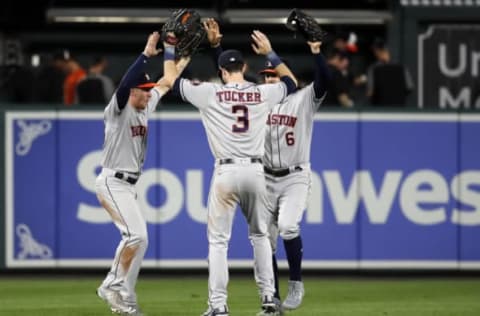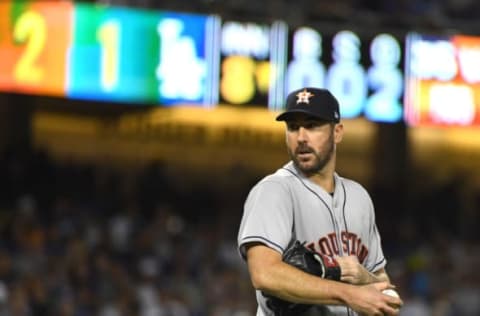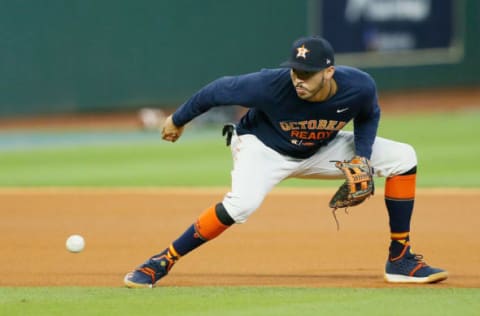What matters for the Astros in 2019


The upcoming 2019 season is an important one for the Astros as the club aims for another World Series run.
Although the Astros fell short of their collective goal in 2018, the 2019 iteration is prime for another round of postseason glory. Sure, there are some notable departures to account for, but the overall talent on this roster is still one of the deepest in baseball. The AL West likely runs through Houston for at least one more season, especially in light of the Mariners’ recent rebuilding effort. The A’s remain as the Astros toughest competition in the division, but the Angels and Rangers should also improve.
There are multiple players on the Astros right now who will impact the club’s immediate future in 2019 along with its long-term direction starting in 2020. Let’s break down who I figure holds the most influence going forward.

Starting Rotation
Justin Verlander: The Astros’ ace starter was one of the best in the game last season (6.3 bWAR/6.8 fWAR), but Verlander will turn 36 during Spring Training. There is no denying the impact of Verlander on this roster since his arrival. Entering the last season of his current contract, it is not known where the star pitcher will end up for 2020 and beyond. While it is unknown if an extension with the Astros is possible, look for Verlander to draw plenty of interest once he hits free agency. There is no doubt that the former Tiger is key to Houston’s direction in 2019 and beyond.
Gerrit Cole: Like I noted with Verlander above, Cole was one of the best starters in baseball in 2018 (5.1 bWAR/6.3 fWAR). Cole is also entering the last season of his current contract in 2019 as he goes through his last round of arbitration. Much like Verlander, it is an unknown whether Cole is willing to sign another contract with the Astros. More likely than not, the Scott Boras client will enter free agency for the first time next fall as there should be no shortage of suitors. If he comes close to replicating, or even exceeds, his 2018 season, any team ought to pay top dollar to have Cole anchor their starting rotation heading into the next decade. If there are two players who hold the keys of the Astros’ immediate future, it has to be Cole and Verlander.
Collin McHugh: McHugh’s transition back to the starting rotation is one of more intriguing storylines as we approach Spring Training. Following a successful season exclusively as a reliever (1.99 ERA in 72 1/3 IP), the Astros will rely on the right-hander to be the club’s number three starter. McHugh definitely has the track record as he has posted a 3.70 ERA in 102 starts for the club, dating back to the 2014 season. You can understand why the Astros chose not to trade McHugh a year ago following the acquisition of Cole. Like Verlander and Cole, McHugh is a free agent following the 2019 season.
Forrest Whitley/Josh James/Framber Valdez: Based on the Astros’ depth chart, James would be the club’s number four starter followed by…Lance McCullers Jr.? It might be time for an update as McCullers will not pitch in 2019 following Tommy John surgery. Still look for the Astros to acquire one more starter in free agency or via trade before Spring Training, much like Cole last offseason. James is likely a option for the number five starter job, but don’t act surprised if Whitley, one of the top prospects in baseball, and Valdez to receive some looks as a starter in 2019 under the right circumstances. The Astros need at least one of the young arms to progress this year with the rotation possibly in flux next offseason.

Position Players
Carlos Correa: I’ve always had an uneasy experience about deciding if a player should be labeled a bust/disappointment due to injuries. Quite a slippery slope if you’d ask me. I tend to express disappointment over the circumstances instead of the player themselves, and that’s how I approach Correa’s injury-prone 2018. At the same time, I’ll also note that the upcoming 2019 season is an important one for the shortstop. We’ve all seen what Correa is capable of at his best (155 OPS+ in 2018). If he can remain healthy for most of the season, expect another five-plus win season from the former number one pick.
Michael Brantley: Likely the Astros’ best acquisition this offseason, Brantley solidifies one of the better lineups in baseball. The left-handed hitter provides a nice balance in Houston’s right-handed heavy lineup as well. For only $32 million over the next two seasons, Brantley represents a nice upgrade with no risk beyond 2020. As long as he remains healthy, the Astros came away with one of the better bargains this offseason.
Kyle Tucker: A top prospect in the Astros’ system, who has been frequently linked in trade talks, Tucker had a rough debut to major league pitching last year (25 OPS+ in 72 PA). However, it is still way premature to declare Tucker a bust. Brantley’s arrival likely forces Tucker to start the season in Round Rock, although he is on the short-list to rejoin the majors if required. Regardless if he remains with the Astros long-term or not, his future will help dictate Houston’s direction.
Jose Altuve/George Springer/Alex Bregman: Injuries were an issue for the Astros last season, and Bregman’s recent elbow surgery doesn’t inspire much relief. But it is only mid-January and it appears that all of the core will be ready to play on Opening Day. If Altuve, Springer, and Bregman along with Correa mange to remain healthy for most of the season, the Astros’ lineup is likely one of the top three in baseball.

Bullpen
Roberto Osuna: By far the most controversial acquisition by the Astros in recent memory, Osuna is the likely closer for the club in 2019. Despite a 12.27 ERA in the ALCS against the Red Sox, the former Blue Jay did post a 1.99 ERA across 12 relief appearances following his trade to Houston. The Astros are counting on Osuna to provide some stability in the backend of the bullpen again in 2019. That said, he ought to be on an extremely short leash for the upcoming season, especially in light of how serious his off-the-field situation was this past year.
Cionel Perez/Framber Valdez (again): The Astros are likely staying within the organization to find a left-handed reliever, which means Perez and Valdez are candidates for the job. If Valdez earns a role in the rotation, then Perez likely has the inside track to the job. Heck, he might anyway even if Valdez doesn’t break camp in the rotation. Of course, Valdez had a successful debut in the majors last season with a 2.19 ERA in 37 innings, some of which came as a reliever.
Next. A rant about the “Hot Stove” and record revenues. dark
Chris Devenski/Will Harris/Brad Peacock/Hector Rondon: Although the Astros had one of the better bullpens by the metrics, there was a bit of volatility within the unit. For example, Devenski, Harris, Peacock, and Rondon were either the ALDS and ALCS roster, or all together. All four had high and low moments during the regular season, but it is clear that the Astros’ confidence in them waned at times. All four could possibly return to key roles in the bullpen in 2019, but we’ll see how Spring Training pans out first.